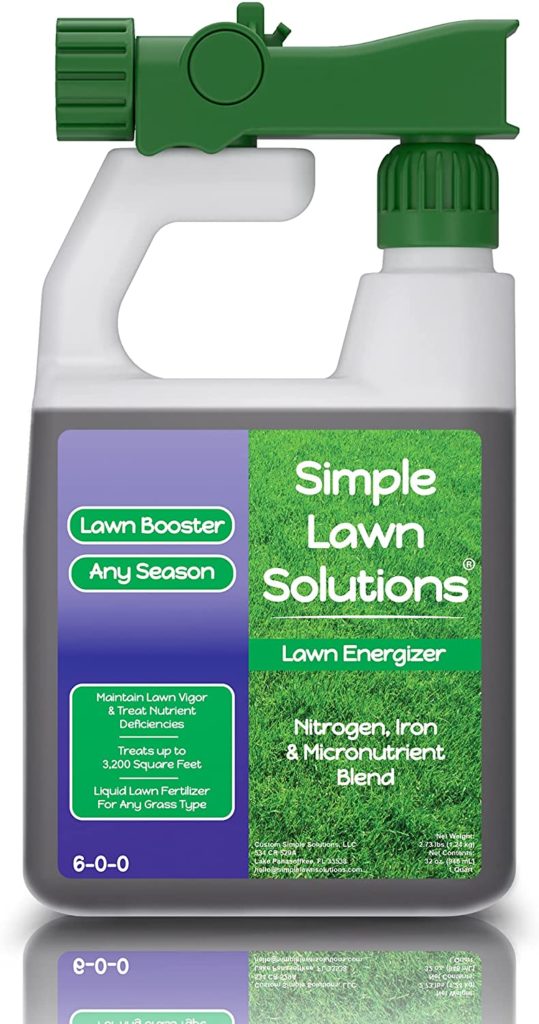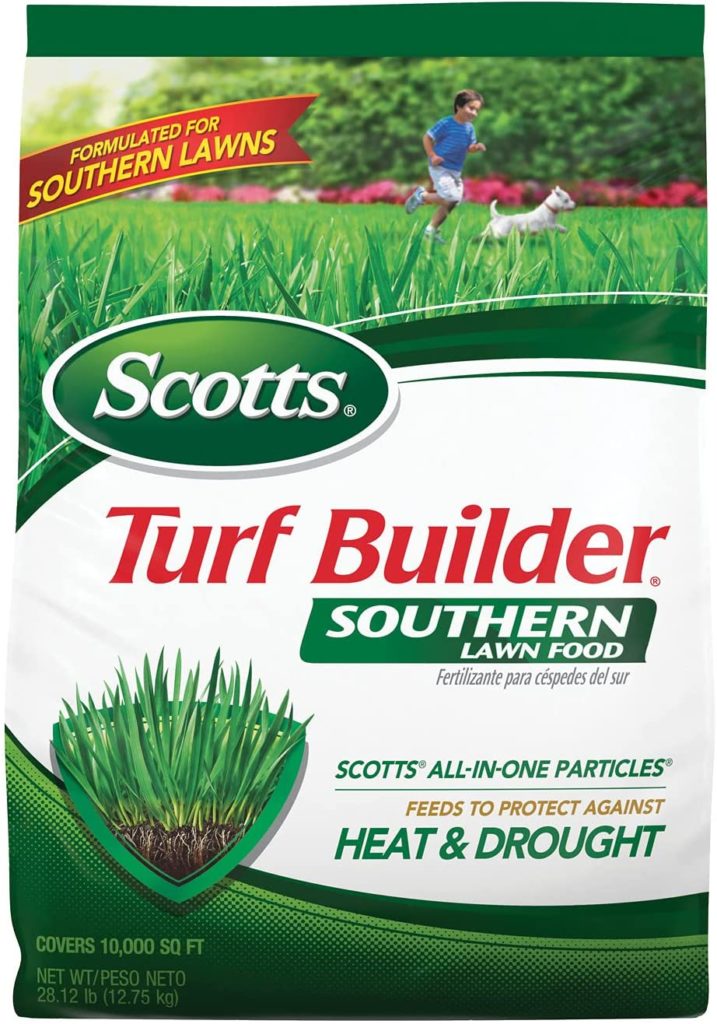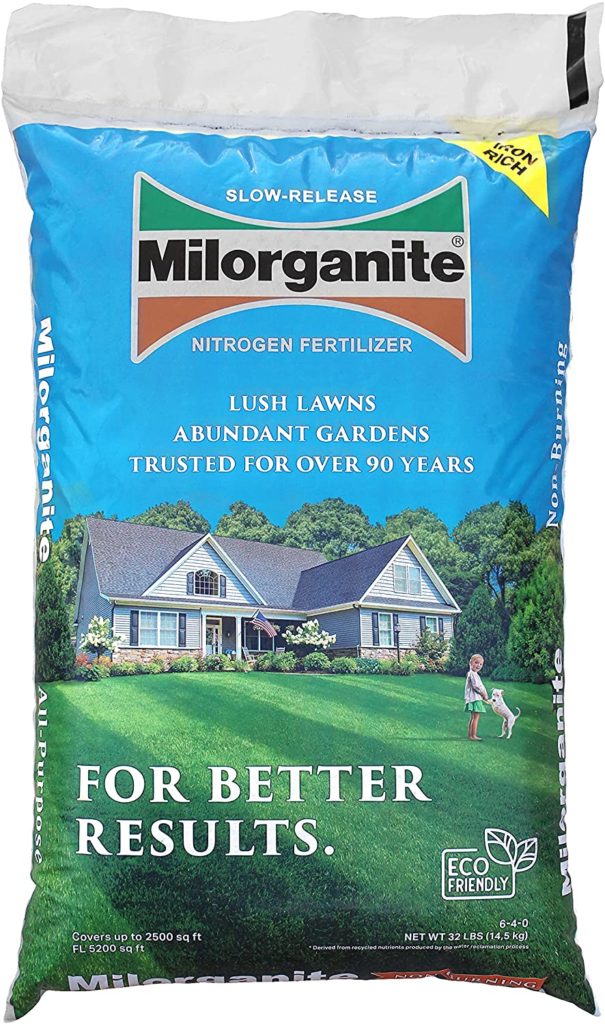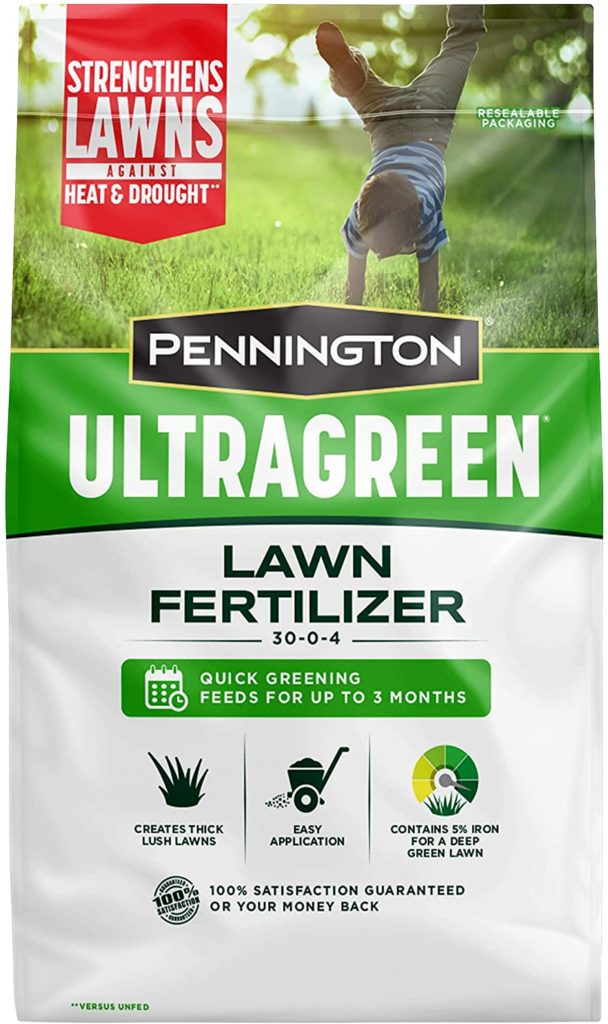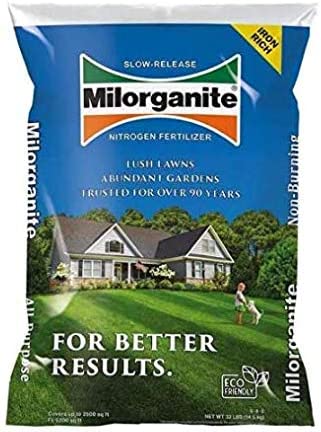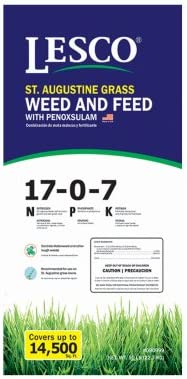Frequent fertilizing is necessary to keep a St. Augustine grass lawn at its best. Fertilizers are necessary if you want the grass on your lawn to remain healthy and greenish enough to survive the effects of environmental stressors like drought, fungus, and disease. Because of this, it is very important to ensure that your St. Augustine consumes the proper diet. Finding the best fertilizer of the highest quality might be challenging due to a large number of available options.
St. Augustine grass is perfect for producing a thick lawn since it grows so fast. Spring is a good time to start your fertilization program. When applied every eight to ten weeks, a rate of one to one and a half pounds of nitrogen per one thousand square feet will provide the best effects.
To have a beautiful lawn, it is very necessary to use a fertilizer that has a high nitrogen content and contains other components such as iron. The use of granular and liquid fertilizers for your St. Augustine lawn will provide the best results. Since organic fertilizer with a delayed release of nitrogen is not nearly as effective as synthetic fertilizer. If you use it, you won’t have to be concerned about your grass being scorched.
But before jumping in to the best fertilizer for St. Augustine Grass it is recommended to know everything about the fertilizers.
6 Best Fertilizers for St. Augustine Grass
The St. Augustine grass has to be maintained in several different ways, including regular hydration. There is a wide variety of fertilizer applications, and one may choose from several different combinations to meet their needs. Here are a few of the best St Augustine grass fertilizers for your reference.
1. Simple Lawn Solutions Lawn Food Natural Liquid Fertilizer
In addition to an important balance of nutrients, the fertilizer offered by Simple Lawn Solutions contains seaweed and fish. The NPK ratio is the optimal decision to make if you want your grass to continue to appear its absolute best.
This combination will not help lawns that are struggling with problems like weeds, fungus, disease, or insect infestations. It is aimed to increase the overall health of lawns that are already in existence.
For instance, this fertilizer is useful for various turf grasses, including Kentucky bluegrass and St. Augustine grass. Because the bottle is equipped with a host attachment, you do not need other devices to give the medication. Simple Lawn Solutions is a company owned and operated by a family and provides a wide variety of services related to lawn care. It was established by individuals who had previously worked in the commercial lawn sector. Because of their 25 years of experience in the commercial lawn care industry, you can rely on their product to provide your expected results.
Features:
- Liquid fertilizer.
- NPK ratio: 6-0-0.
- Ready-to-use from the bottle.
Direction for Usage:
Even distribution of the product may be achieved by connecting the bottle to your hose. With our all-in-one liquid fertilizer, you can have a greener lawn in minutes by attaching your hose to it and spraying it. As little as 1-2 inches of water is needed. Directly spray across the lawn to keep your grass looking its best. Apply them during the grass’s active growth season to get the most out of the products.
- Using the low-nitrogen mix, you obtain healthy roots and lovely grass blades
- The beauty of your grass improves immediately with the use of this fertilizer
- The application is easier to manage because of the liquid formulation
- It doesn’t need any specific equipment to use
- Slightly unpleasant odor
- The formula requires more frequent reapplication than many granular choices
2. Scotts Turf Builder Lawn Food
Lawns in the South, where summers may be very hot and dry, need the usage of specialized lawn food, which is why Scotts Turf Builder Southern Lawn Food was developed specifically for use on southern lawns. Because of the high concentration of nitrogen released over a prolonged period, this fertilizer promotes healthier, denser, and lusher grass growth. The unique All-in-One Particles developed by Scotts prevent the grass from being scorched, which may happen when nitrogen fertilizers are used, and equitably distribute nitrogen and other nutrients.
Utilizing this Scotts fertilizer while starting a new lawn is an excellent method to ensure that your grass gets off to a healthy start. It encourages fast growth that may be up to 70 percent thicker and 35 percent quicker than grass that has not been treated. The NPK ratio of 24-25-4 is optimal for fostering quick root development and producing blades of greater strength. This approach works well on St. Augustine grass. The growth of new plants is not the only possible use for this particular fertilizer. Additionally, it performs well with lawns already planted, grass plugs, and even sod.
Features:
- Compound: Granular fertilizer.
- NPK ratio: 32-0-4.
- Slow-release time release.
- Effective for six weeks.
- Package Weight: 14 pounds.
- 5,000 square feet of coverage.
Direction for Usage:
You have to water the grass deeply enough to reach the roots. The little grains soak up quickly into the earth and begin working immediately. Until the soil becomes green, keep applying the solution to a damp area and feeding it. It is important to read the handbook to learn about the amount before using the tool.
- Perfect for warm-season grasses like St. Augustine’s lawns and gardens
- Phosphorus-free
- Suitable for a wide range of lawns
- The ability to resist heat and dryness
- Over-fertilizing might harm the grass
- There is a shorter shelf life than with other slow-release fertilizers
3. Milorganite 0636 Nitrogen Fertilizer
The use of milorganite has no negative impact on St. Augustine grass. Milorganite, in contrast to other types of fertilizer, does not pose the risk of an excess of nitrogen, which may be harmful to grass since it causes the plant to lose moisture. Because of this, microorganisms that are already present in the soil will slowly release nitrogen and other nutrients when your grass needs them.
The absence of phosphorus in milorganite makes it an excellent choice as a fertilizer for St. Augustine. Milorganite’s nitrogen fertilizer is made from recycled nutrients, making it an ecologically responsible product.
This kind of fertilizer, as opposed to synthetic fertilizers, includes organic matter, and as a result, it not only improves the structure of the soil, but it also provides benefits to the soil microorganisms that are necessary for healthy grass growth, such as bacteria and earthworms.
In addition, the cost of this organic fertilizer is much lower than the cost of other forms of organic fertilizers. This “all-purpose” fertilizer may be beneficial to a wide variety of plants, not only St. Augustinegrass, so don’t limit its use to just one kind of grass.
Features:
- Granular compost
- NPK ratio: 6-4-0
- Slow-release
- In effect for ten weeks
- A package weighing 32 lbs
- A total of 2,500 square feet is covered
Direction for Usage:
Apply Milorganite on your lawn after the last frost and when it starts to develop and green-up in spring. Soil temperatures should be in the mid-fifties if the daytime temperature is constantly in the 60s. If you fertilize too early, the plant will prioritize shoot growth over root development, resulting in a lack of root development.
Your grass will be able to better tolerate the dry weather of the summer months if it has deep roots. Apply Milorganite near the end of the season, right before the first heavy cold or snowfall, to ensure that your plants are ready for winter.
- An organic, ecologically friendly substance was used in its manufacture
- Long-term effects
- Affordable
- Ensures a lush, green lawn with this product
- Not for use in places where phosphorus fertilizer is prohibited
- No potassium in this product
- OMRI-approved for organic gardening
4. Pennington UltraGreen Starter Lawn Fertilizer
Your lawn will have a deeper, more vibrant shade of green if you use this Pennington Ultra Green Starter Grass Fertilizer, which contains 5% iron. Furthermore, it contributes to the growth of a strong root system and encourages a more quick and enhanced greening of the plant.
Thus, it has both immediate and long-lasting impacts on nitrogen. The ratio of nitrogen, phosphorus, and potassium that is 30-0-4 will be beneficial to your grass since it is a perfect combination of these three elements. Since it covers such a large area, you don’t need to worry about covering a substantial portion of your grass.
Because of the high concentration of nitrogen and iron in Pennington’s lawn fertilizer, UltraGreen, your grass will become thick and dark green in less than a month. The fertilizer contains slow-release nitrogen, which guarantees that your lawn will continue to get a consistent supply of nutrients for many months to come. Because it shields the grass from the intense heat and dryness of the South, UltraGreen is an excellent choice for St. Augustine lawns in that region. The late spring and summer months are the most productive seasons for feeding.
Features:
- Type: Granular fertilizer.
- NPK ratio: 30-0-4.
- Instant and slow release.
- Duration: 12 weeks.
- Package size: 14 lbs.
- 5,000 square feet of coverage
Direction for Usage:
Re-seeding, over-seeding, or fixing bare patches in existing lawns are all possible uses for this product. Water well after applying equally to the grass when it’s dried. If you use a spreader to apply fertilizer to your lawn, start by applying it around the perimeter, then run the spreader back and forth over the area. If you wondering weather you can apply grass seed and fertilizer at the same time then answer is simply yes, but it has some parameters that you should follow.
To eliminate gaps in coverage, always leave a little amount of overlap in your plans. Remove surplus fertilizer granules from hard surfaces by raking them into the grass. It is best to apply in the spring or fall when the temperature is over 50 degrees Fahrenheit but not beyond 90 degrees Fahrenheit.
- Utilizing nitrogen fast-acting and slow-release for long-term results
- Free of phosphorus to keep stormwater flow clean
- The fertilizer is simple to use and apply
- The grass will burn and become brown if you over-fertilize with a nitrogen-rich combination
- Soils deficient in phosphorus will not benefit from this product
5. Milorganite 0636 Organic Nitrogen Fertilizer
It is safe to use milorganite on St. Augustine grass since it does not affect the grass in any way. When you use Milorganite, you won’t have to be concerned about an excessive amount of nitrogen, which may harm grass by causing it to lose too much water. As a direct result of this, soil bacteria will gradually release nitrogen as well as other nutrients over the course of time, in accordance with the requirements of your grass.
As a result of the absence of phosphorus, St. Augustine may utilize milorganite as a fertilizer without fear of consequences. This product is completely free of any chemicals. The addition of a little quantity of nitrogen to the soil by Milorganite’s Organic Natural Fertilizer contributes to the development of St. Augustine grass, which is more lustrous and thick. The NPK ratio of organic fertilizer that has been produced from composted manure is 6-4-0.
When used with either a drop spreader or a broadcast spreader, a single 32-pound bag of Milorganite granules has the potential to treat up to 2,500 square feet of grass. Organic fertilizer is beneficial to the surrounding ecosystem, does not contaminate streams, and does not harm aquatic life, making it an excellent choice for usage on agricultural land and in orchards.
Features:
- NPK ratio: 6-4-0
- Slow release fertilizer
- Rich in iron content
- Nitrogen fertilizer
- Product weight: 32 lbs.
Direction for Usage:
Turd must be prepared by first tilling the soil. To prepare the soil, add 2–4 inches of Milorganite to the topsoil. On top of the soil lay a layer of sod. Before spreading St. Augustine sod, it’s a good idea to fertilize the topsoil.
This will ensure that the sod has easy access to nutrients as it grows. It’s difficult to get fertilizer to the topsoil after the sod has been set, so this step is important for the healthy root development of the sod.
- Grass will not be damaged by organic formulation
- Helps to strengthen the roots
- Slow-release promotes grass with greenish leaves
- Smells bad when first applied
6. Lesco Professional St. Augustine Weed & Feed Fertilizer
St. Augustine grass Weed and Feed with Penoxsulam is an excellent choice for managing dollarweed and other invasive plants that are difficult to manage. It is possible to apply it while weeds are actively developing and spreading. This bag has the capacity to treat up to 14,000 square feet, which is sufficient to treat an area equal in size to a typical lawn. It has been supplemented with fertilizer 17-0-7.
Lesco, one of the most well-known and respected brands, is in the business of manufacturing St. Augustine grass fertilizer. Not only does professional-grade fertilizer like Lesco’s 17-0-7 weed and feed have the required quantities of nitrogen, but it also has extra nutrients like iron.
If you want your lawn in the southern United States to be thick and lush with greenery, the fertilizer that Lesco sells is a great option to consider. The iron is a godsend for lawns that have a tendency to develop brown spots. The spring season is the most suitable period to apply this fertilizer. Your St. Augustine grass will start growing and greening more quickly as a result of this, which is essential for smothering weeds in the lawn.
Features:
- NPK ratio: 17-0-7
- Granular fertilizer
- Slow release formula
Direction for Usage:
For effective and speedy weed management, use a broadcast spreader to apply granules. It Is Preferred That You Apply The Fertilizer When The Grass Is Wet. To achieve the best results, give it time to dry completely; you will get the best results in about two weeks. It’s safe for floratam varieties to use. The slow-release formula can offer up to 8 weeks’ worth of nutritional support.
Also Read: How Long Does Fertilizer Take to Work? All You Need to Know
- Controls dollar weed and other hardy weeds with great success
- Protects up to 14,000 square feet of grass and helps it stay greener for the long term
- Granules should be used using a broadcast spreader for the best weed control
- It’s a little expensive
Frequently Asked Questions:
• Fertilizer should be administered to St. Augustine grass 2-6 times a year from spring through autumn. The only exception to this rule is if you reside in South Florida.
• Pay attention to the timing of fertilizer applications in the spring growing season. Thanks to the milder climate, St. Augustine grass and fertilizer use are year-round activities in southern Florida.
• In the northern hemisphere, the last fertilizer application season should begin toward the end of September. Final applications should be completed sooner as you go northward.
You can Also Read: When to Fertilize New Grass ? Everything You Should Know
Reduce the mixture by half, observe the situation, and reapply, if necessary, just to the affected regions.
Yes. The fertilizer might wash away if water is still streaming off the lawn after being watered. Wait for a few minutes for the water to observe the soil, and then start applying the fertilizer.
Nitrogen burning may occur if St. Augustine grass is over-fertilized. Nitrogen burns may cause the grass to become yellow or brown and cause root damage. As a result, the over-fertilized grass might perish. When applying a nitrogen-rich, liquid, or fast-acting fertilizer, you are particularly in danger of burning your grass. Apply these fertilizers with extreme care.
Conclusion
The vast majority of lawns would benefit greatly from being planted with St. Augustine grass. Since it is so hardy and thick-skinned, it may flourish in various weather and soil conditions. Like many other types of turf, St. Augustine grass does need some level of human intervention to be healthy and successful.
It is essential that while caring for St. Augustine grass, the appropriate fertilizer is used and applied consistently. By using a high-quality fertilizer, St. Augustine grass has the potential to regain its previous liveliness while also being shielded from any future problems.

